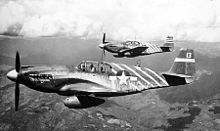Philip Cochran
Philip Gerald Cochran | |
|---|---|
1st Air Commando Group | |
| Battles/wars | World War II
|
| Awards | Croix de Guerre (France) |
Philip Gerald Cochran (born in
Early life
After earning a business degree from Ohio State University in 1935, Cochran enlisted as a pilot in the Army Air Corps because "it looked like a good way to make an easy living."[2]
Cochran knew Milton Caniff at Ohio State, so he approached him in 1941 to design an insignia for his 65th Fighter Squadron [3] (predecessor of the modern 65th Aggressor Squadron.) After watching Cochran's squadron, Caniff thought Cochran and his squadron had potential as characters for comics. Cochran became famous during the war as the model for the character Flip Corkin, a character in the comic strip Terry and the Pirates.[4] Later, Cochran became the model for another character in the Caniff comic strip Steve Canyon. Cochran's character was named General Philerie; a combination of his first name, Phil, and his hometown, Erie.
World War II
North Africa
Major Cochran led the 33rd Fighter Group's "advanced attrition" fighter planes and replacement pilots to the North African campaign. His men called themselves the "Joker Squadron"[2] because the squadron had been designated as "J Squadron" in the plan for the landings in North Africa. In December, 1942 he took the 58th Fighter Squadron into the captured advanced airfield at Thelepte, an airfield in western Tunisia. His Deputy Commander called him "a colorful individual, a natural leader. He was aggressive, but not ambitiously so". Cochran was soon mentioned in press reports.[5] While flying from Thelepte, Cochran dropped a 500-pound bomb; it skipped directly into the German headquarters at the Hotel Splendida, Kairouan, Tunisia.[6] He destroyed telegraph wires by flying over them with a lead weight on the end of a wire attached to the wing of his pursuit plane, a tactic he employed later in Burma. By the end of hostilities in the theater, he had shot down two German fighter planes.[7]
Although a fighter pilot, Cochran flew the lead
Cochran developed a reputation for 'getting the job done', and had little respect for those he believed were obstructing him, regardless of rank. On one occasion, Cochran clashed with General
Burma
Cochran, by now a lieutenant colonel, and

Col. Cochran ordered the 1st Air Commando to support ground troops without reservation: his sense of humor, aggressiveness, and willingness to risk his planes and pilots in daring support missions soon won the admiration of many officers and men of the Indian Army, who, up to that point, experienced lackluster support from hard-pressed Royal Air Force squadrons.[12] In particular, the news Cochran would make light planes and gliders (snatched from the ground by low-flying C-47s) available to evacuate wounded men from combat greatly-increased the morale of the long-range jungle penetration forces. One Brit commander summed the change:
"The commanders' hopes and the soldiers' morale rose sky-high. Now, if we got hit in the middle of Burma, we would not be left under a bush to die."[13] Cochran's infectious confidence and unstinting support for Allied operations in Burma caused Admiral Mountbatten to remark to Cochran: "My boy, you are the only ray of sunshine in this theatre this year."[8]
1st Air Commando was also called upon to perform ground support missions for the Long Range brigades, including bombing and strafing attacks. In one incident, the group's
Postwar
Cochran was director of aerial scenes in the Howard Hughes film Jet Pilot starring John Wayne and Janet Leigh.
Col. Cochran eventually retired from the USAAF, returning home to Erie, Pennsylvania, US. There he joined his brother John's company, Lyons Transportation Lines, where he would eventually become chairman of the board.
Cochran dated actress Betty White in the early 1960s after being introduced by Jack Paar. White declined his marriage proposal; later dating Cochran and her future husband Allen Ludden simultaneously, until her romance with Ludden became serious.
Cochran also became active in charitable organizations such as the Pennsylvania Heart Association. He was a consistent supporter for Erie's Gannon University, and attended many USAAF reunions. Cochran died of a heart attack while fox hunting in Geneseo, New York, in 1979.[2][15]
Notes
- ISBN 1-57488-775-0.
- ^ a b c "Col. Philip Cochran". Pennsylvania Historical and Museum Commission. 2003. Retrieved 2008-06-08.
- ^ Letter from Col Cochran
- ^ "Escape Artist". Time. 1947-01-13. Archived from the original on October 24, 2012. Retrieved 2008-06-08.
- Daily News. Retrieved 2008-06-08.[permanent dead link]
- ISSN 0002-2241.
- ^ Weber, Mark (2008). "Colonel Philip G. Cochran, USAAF". Erie Hall of Fame. Retrieved 2008-06-08.
- ^ a b Allison, John. Phil Cochran: The Most Unforgettable Character I've Met.
- ISSN 0730-6784. Archived from the originalon 2007-11-05. Retrieved 2008-06-08.
- ^ "95 Year Old Air Commando Legend Shares History with Today's Special Operators". Archived from the original on 2013-11-04.
- ^ a b Masters, 1979, p. 197–198.
- ^ Masters, 1979, p. 146–148.
- ^ Masters, 1979, p. 146.
- ^ Masters, 1979, p. 198–199.
- ^ "Col. Philip G. Cochran, War Hero and Model for 2 Cartoon Figures". The New York Times. August 27, 1979. p. D7.
References
- Busch, Briton Cooper. Bunker Hill to Bastogne. Potomac Books, Inc., 2006. ISBN 1612342736, 9781612342733.
- Masters, John (1979). The Road Past Mandalay. ISBN 0-553-12662-8.
Liebling, A. J. GUERRILLA FROM ERIE, PA in NEW YORKER BOOK OF WAR PIECES, New York, Reynal and Hitchcock, 1947, pp. 136–144. From The New Yorker, 2/13/1943
